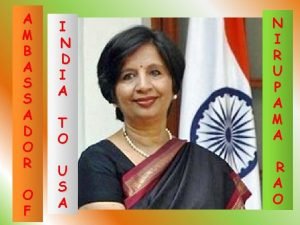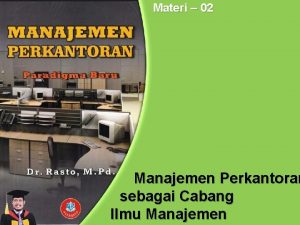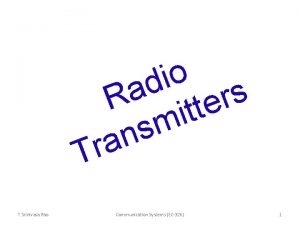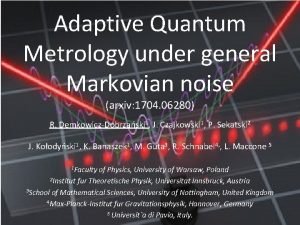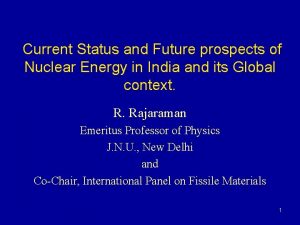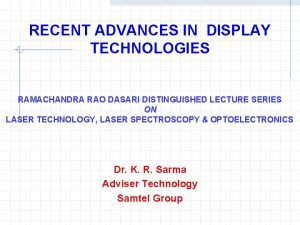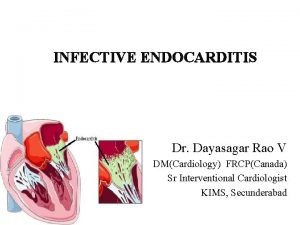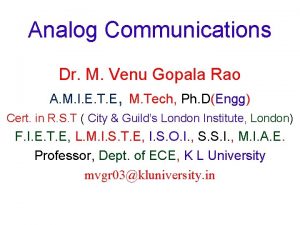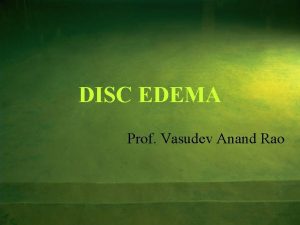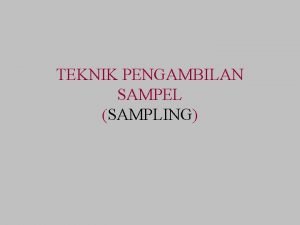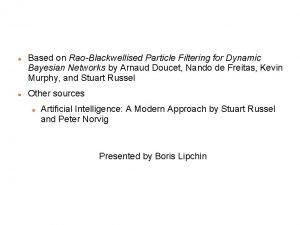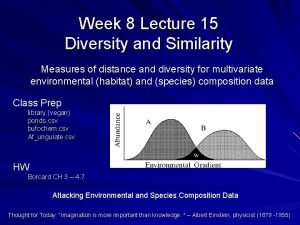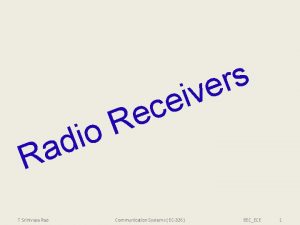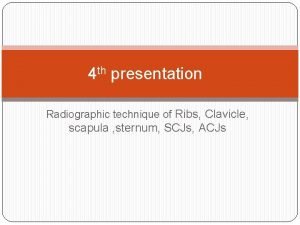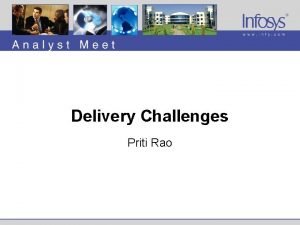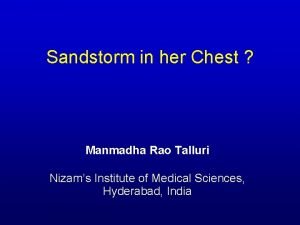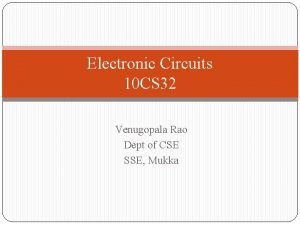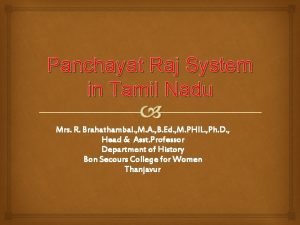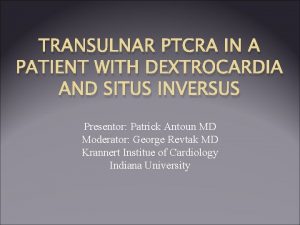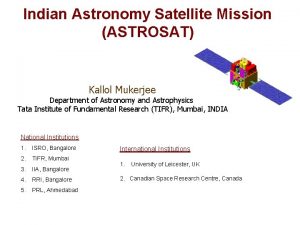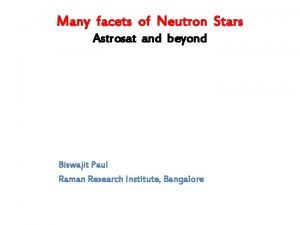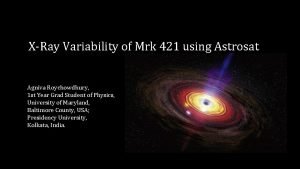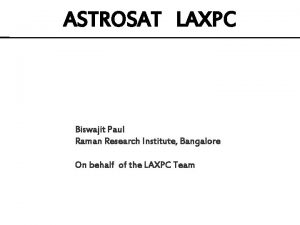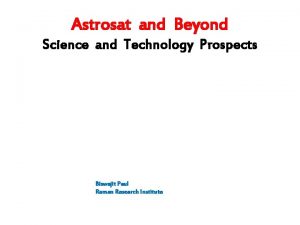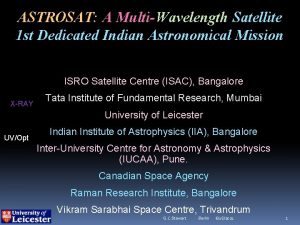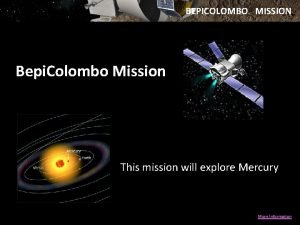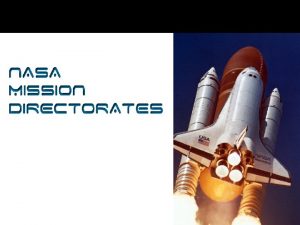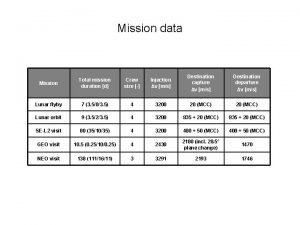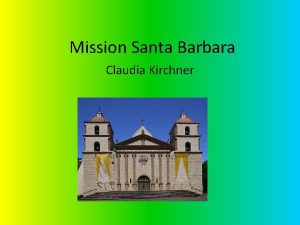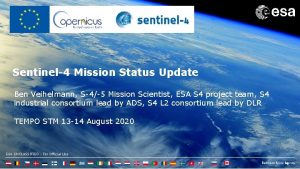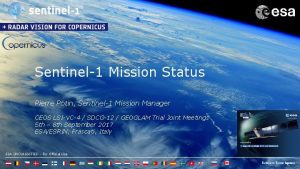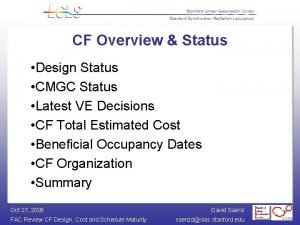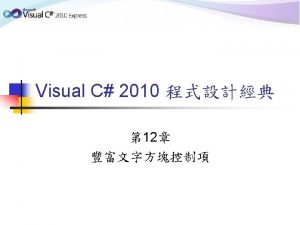Status of the Astrosat mission A R Rao




























- Slides: 28

Status of the Astrosat mission A R Rao Tata Institute of Fundamental Research, India

Plan �Astrosat Instruments: - Ultraviolet Imaging Telescope (UVIT) - Large Area Xenon Proportional Counters (LAXPC) - Soft X-ray Telescope (SXT) - Cadmium Zinc Telluride Imager (CZTI) - Scanning Sky Monitor (SSM) �Calibration - CZT – Imager �Conclusions 13 -May-14 A. R. Rao IACHEC meeting 2

ASTROSAT LAXPC UVIT SXT CZTI Star Sensors SSM 13 -May-14 A. R. Rao IACHEC meeting 3

Participating Institutes… �ISRO Centers Satellite, rocket, T&E, Launch, Orbit, SSM, Level 1&2 software + overall management �Research Institutes Tata Institute of Fundamental Research LAXPC, CZTI, SXT Indian Institute of Astrophysics UVIT IUCAA SSM, CZTI RRI LAXPC PRL, Universities, � Leicester Uty (SXT), Canadian Space Agency (UVIT) 13 -May-14 A. R. Rao IACHEC meeting 4

ASTROSAT � IRS (Indian Remote Sensing) Class � Launch PSLV from SHAR � Altitude : 650 km; Inclination : 6 deg. � Mass 1550 kg. (780 kg. Payloads) � Power : 2200 watts � 200 Gb (210 Mb/sec) � Satellite Positioning System for orbit and time data � Payload pointing (3 ): 0. 05 degree � Slew rate : 0. 6 deg/sec � Launch: Second quarter of 2015 � Operational life > 5 years Slide courtesy: K S Sarma 13 -May-14 A. R. Rao IACHEC meeting 5

UVIT: Two Telescopes, Three Bands �f/12 RC Optics �Focal Length: 4756 mm; Diameter: 38 cm �Simultaneous Wide Angle ( ~ 28’) images in FUV (130 -180 nm) in one and NUV (180 -300 nm) & VIS (320 -530 nm) in the other �MCP based intensified CMOS detectors �Spatial Resolution : 1. 8” �Sensitivity in FUV: mag. 20 in 1000 s �Temporal Resolution ~ 30 ms, full frame ( < 5 ms, small window ) �Gratings for Slit-less spectroscopy in FUV & NUV (R ~ 100) Getting ready for satellite integration (next 2 months). 13 -May-14 A. R. Rao IACHEC meeting 6

Soft X-ray Telescope (SXT) Telescope Length: 2465 mm (Telescope + camera + baffle + door) Focal Length: 2000 mm Epoxy Replicated Gold Mirrors on Al substrates in conical Approximation to Wolter I geometry. Radii of mirrors: 65 - 130 mm; Reflector Length: 100 mm No. of nested shells : 40 No. of reflectors: 320 (40 per quadrant) Detector : E 2 V CCD-22 (Frame-Store) 600 x 600 Field of view : 41. 3 x 41. 3 arcmin PSF: ~ 2 arcmins Sensitivity (expected): 15 Crab (0. 5 cps/m. Crab) Calibrated and Integrated with satellite (next talk: A. Read) Slide courtesy: K P Singh A. R. Rao IACHEC meeting 13 -May-14 7

LAXPC: Large area Xenon-filled Proportional Counters Energy range : 3 – 80 ke. V Time Resolution: 10 sec Area Three identical xenon filled proportional counters. Multi layer and multi cell geometry with 60 anode cells and 28 anti cells : 6000 cm 2 (7980) E / E ~ 3 - 7 One Unit calibrated and delivered for satellite integration. Xenon + methane mixture at a pressure 1500 mm of Hg. 50 micron thick aluminized Mylar window with a FOV of 1 ox 1 o 13 -May-14 A. R. Rao IACHEC meeting 8

CZT-Imager Size: 482 x 458 x 603 mm Heat pipes CFRP support Weight - 50 kg Power – 60 Watts Collimator: 6 x 6 Degree 17 x 17 Degree Handling brackets CAM Collimator Side joining plates CZT top hsg. Radiator Optical cube Alpha tag source CZT bottom hsg.

Area 1024 cm 2 Pixels 16384 Pixel size 2. 4 mm X 2. 4 mm (5 mm thick) Read-out ASIC based (128 chips of 128 channels) Imaging method Coded Aperture Mask (CAM) Field of View 17 X 17 deg 2 (uncollimated) 6 X 6 (10 – 100 ke. V) – CAM Angular resolution 8 arcmin Energy resolution 5% @ 100 ke. V Energy range 10 – 100 ke. V - Up to 1 Me. V (Photometric) Sensitivity 0. 5 m. Crab (5 sigma; 104 s) Calibrated; final testing going on (Satellite Integration in next 2 months) 13 -May-14 A. R. Rao IACHEC meeting 10

Scanning Sky Monitor (SSM) • 3 PSPC; Area 60 cm 2 (5 ke. V); Ang res. : 2. 5 o & 12’ • Energy Res 20%@ 6 ke. V Flight Models are being tested (Satellite Integration in next 2 months) 13 -May-14 A. R. Rao IACHEC meeting 11

Payload integration, alignment & testing: December 2014; Launch: mid-2015 Slide courtesy: S S Sarma 13 -May-14 A. R. Rao IACHEC meeting 12

Astrosat: Special Features • Low Inclination • Continuous time-tagged individual photon data (LAXPC & CZTI) – a few tens of micro-second accuracy • Bright source observing capability of SXT • Facility to change/ adjust observation time of SSM pointing. • Hard X-ray (above ~ 80 13 -May-14 ke. V) monitoring capability. 13 A. R. Rao IACHEC meeting

Astrosat calibration: ground & onboard Slide courtesy: G C Dewangan 13 -May-14 A. R. Rao IACHEC meeting 14

CCD: X-ray illumination CCD: Optical illumination Mn Kα, Kβ 145 e. V resn. Slide courtesy: K P Singh 13 -May-14 A. R. Rao IACHEC meeting 15

LAXPC Calibration Radio-active sources for Spectral Calibration. GEANT 4 simulation for background estimation 13 -May-14 A. R. Rao IACHEC meeting 16

CZT Calibration � 4 Quadrants � 64 Detectors � 16, 000 pixels �Multi- temperature, multi-sources 13 -May-14 A. R. Rao IACHEC meeting 17

Physics based model and fraction of counts in tail Mu-Tau based method: Photo-peak Efficiency 59. 54 ke. V 81 ke. V 122 ke. V 99% 87% 84% 13 -May-14 A. R. Rao IACHEC meeting 18

CAM calibration: 2 m length A few arc-seconds could be achieved. 13 -May-14 A. R. Rao IACHEC meeting 19

§ The time difference (Delta T) in units of micro-seconds, is well within the expected calibration for pulse from a normal (1 ppm) clock. 13 -May-14 A. R. Rao IACHEC meeting 20

Polarization Crab 3 sigma detection in < 1 day Next (%) 1: 2 3: 4 4: 5 Obs 2. 4+0. 1 4. 3+0. 2 0. 8+0. 1 8. 0+2. 0 Monte Carlo 2. 43 4. 9 1. 0 10. 0 13 -May-14 A. R. Rao IACHEC meeting 21

Modulation Curve at 0 degree 10. 78 % edge modulation fator 4. 8 % corner modulation factor -7. 802 % edge modulation fator 2. 57 % corner modulation factor Modulation Curve at 90 degree 13 -May-14 A. R. Rao IACHEC meeting 22

Polarization measurement capability of CZTI Arrows represent incident polarization direction Slide courtesy: Santosh Vadaw

Onboard Calibration �Low Energy: standard sources �High energy: Crab 13 -May-14 A. R. Rao IACHEC meeting 24

ASTROSAT: Observation Phases and Data Policy 13 -May-14 A. R. Rao IACHEC Slide meeting courtesy: 25 K S Sarm

Science Working Group and Payload Science Teams �PI: S Seetha (seetha@isro. gov. in) �UVIT: S. Tandon (sntandon@iucaa. ernet. in) �LAXPC: J. S. Yadav (jsyadav@tifr. res. in) �SXT: K. P. Singh (singh@tifr. res. in) �CZTI: A. R. Rao (arrao@tifr. res. in) �SSM: M. C. Ramadevi (ramadevi@isac. gov. in) 13 -May-14 A. R. Rao IACHEC meeting 26

`Hard X-ray Astronomy: Astrosat and Beyond’ �A conference in Goa: September 24 - 26, 2014 13 -May-14 A. R. Rao IACHEC meeting 27

Conclusions �Wide band X-ray spectroscopy is the strength of Astrosat. �Extensive ground calibrations completed. Results are as expected. �New features (individual photon counting and possibly polarization) will enhance the observation capabilities. �Onboard calibration will center around Crab observation for high energy instruments. 13 -May-14 A. R. Rao IACHEC meeting 28
 Telemedicn
Telemedicn Pengertian sistem menurut rao met
Pengertian sistem menurut rao met Khắp trên trời truyền rao
Khắp trên trời truyền rao Rao
Rao Cramer rao inequality
Cramer rao inequality Dr anil rao
Dr anil rao Sumathi rao
Sumathi rao Iv rao
Iv rao Dr dayasagar cardiologist kims
Dr dayasagar cardiologist kims Dr. m. venu gopala rao
Dr. m. venu gopala rao Champagne cork appearance of optic disc
Champagne cork appearance of optic disc Rumus sampel arikunto 2013
Rumus sampel arikunto 2013 Attilio rao
Attilio rao Rao blackwell particle filter
Rao blackwell particle filter Amos rao
Amos rao Russell rao distance
Russell rao distance Rao
Rao Rpo ribs
Rpo ribs Priti rao infosys
Priti rao infosys Gayatri rao fda
Gayatri rao fda Amos rao
Amos rao Michelle rao
Michelle rao Dr. talluri. manmadha rao
Dr. talluri. manmadha rao Rao
Rao Gvk rao committee recommendations
Gvk rao committee recommendations Ataxia definition
Ataxia definition Rama rao md
Rama rao md Goutham rao md
Goutham rao md Rao
Rao
